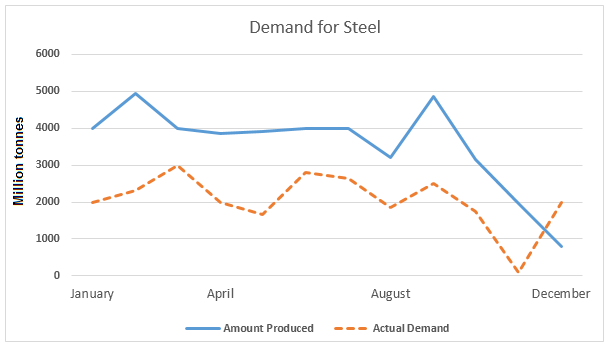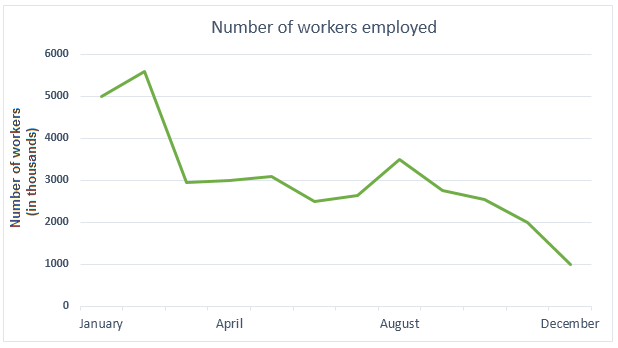IELTS graph 260 - Production and demand for steel in the UK in 2010
- Details
- Last Updated: Thursday, 18 October 2018 19:25
- Written by IELTS Mentor
- Hits: 119851
IELTS Academic Writing Task 1/ Graph Writing - Line Graphs:
» You should spend about 20 minutes on this task.
The line graphs below show the production and demand for steel in million tonnes and the number of workers employed in the steel industry in the UK in 2010.
Summarize the information by selecting and reporting the main features, and make comparisons where relevant.
You should write at least 150 words.


Sample Answer 1:
The first line graph compares the steel production and the demand in the UK in 2010 while the second one reveals the employee number in the industry in the same year. Overall, the production of steel was higher throughout the year than that of the demand except in December and the highest number of employees was employed in this industry at the beginning of the year.
According to the first graph, the UK produced 4000 million tonnes steel in January 2010 and at that time the demand was exactly half of that. After the first quarter, the production and needs for steel remained almost the same. At the end of the second quarter, August, the UK’s steel production stool at just over 3 thousand million tonnes against a million tonnes less demand. From January to November, the production was higher than the demand and the gap between these two was on average a million tonne. However, the scenario shifted dramatically at the end of the year. From September to November, the steel production plummeted and so did the demand. In December, the demand for steel exceeded the total production.
The second line graph reveals that 5 million employees worked in the steel industry and this number dropped to two million less in April. From that time onward, the employee number showed some fluctuations and in August, the UK steel sector employed around 3.5 million workers. This number continuously dropped throughout the rest of the year and declined to 1 million in December.
Sample Answer 2:
The line graph outlines the production and demand for steel in million tonnes in the UK in 2010 and the number of workers employed in this sector. Generally speaking, the production of steel in the UK was higher than the demand and the number of workers in this sector directly affected the production capability.
At the beginning of 2010, the demand for steel was 4000 million tonnes which was double than the actual demand. The steel production and demand in April remained almost the same in April. In August, at the end of the third quarter, the demand unchanged but the production dropped to just over 3000 million tonnes. The demand dramatically fell in November and at the end of the year, the demand went higher than the production. During this time the demand for steel was 2000 million tonnes against less than 1000 million tonnes production.
The production of steel is correlated with the employed workers in this sector. In January 2010, the steel industry in the UK employed 5 million workers and it went as high as roughly 5.8 million in February. From March to July, the workers’ number stood at an average 2 million and kept on declining from September till December. At the end of the year, the UK steel sector employed 1 million people.
Model Answer 3:
The first line graph presents a comparative analysis of the market requirement for steel and production of this material in 2010 in the UK. The second graph shows the total number of workers employed in this industry in the same year. Overall, the steel production in the UK in 2010 sur-plused the demand, except at the end of the year.
The production of steel throughout the time exceeded the demand. In the first quarter of the year, the actual market call for steel started at 2000 million tonnes in January, but production was two times with a continuous rise. Later somewhere in April, the demand started reducing, but production was soaring and reached 5000 million tonnes. Moreover, demand showed further fluctuations approximately till November and fell to almost zero whereas production of the steel attained plateau for some time with further variations and started falling later. After that, in December the demand was nearly double than the production.
From the second graph, it is evident that the total number of workers in the steel industry in the UK was 5000,000 in January and it rose for a month or so. But it then showed a sudden plunge and reached 3000,000 by April, with further fluctuations in number till August. However, the number of workers continued to fall and reached 1000,000 by the end of the year.
[Written by - Divya]

Report